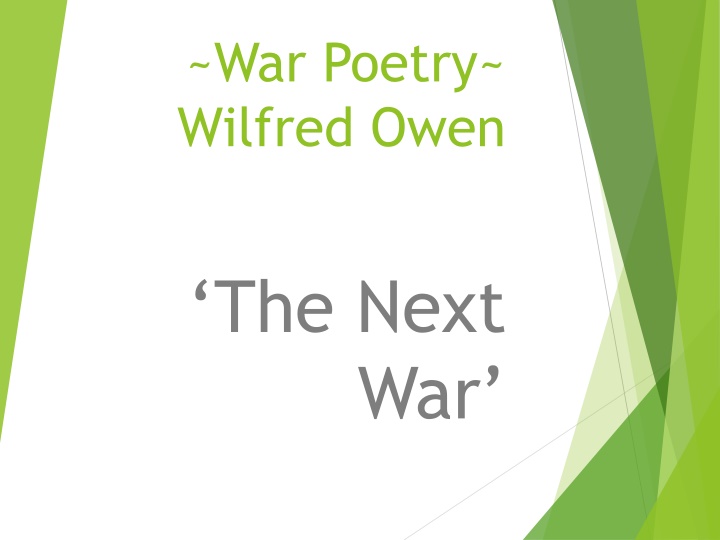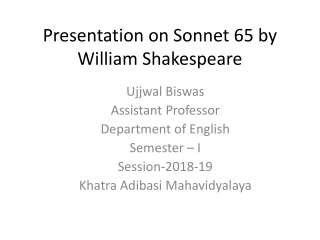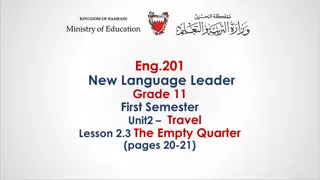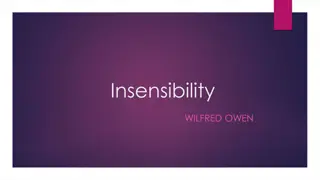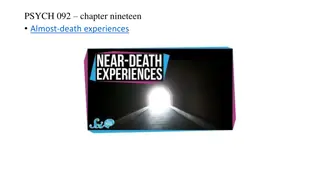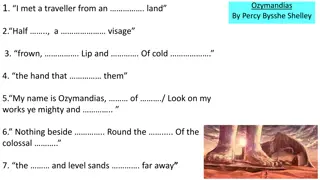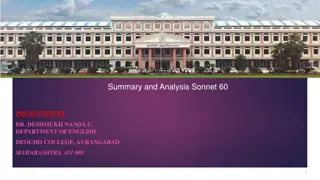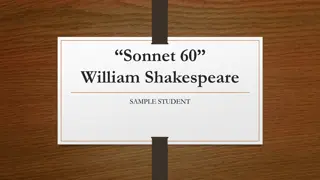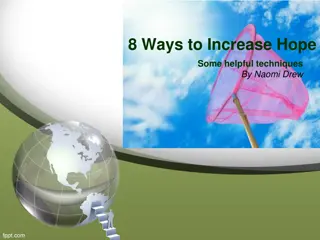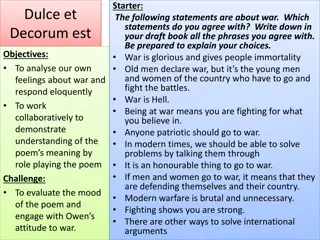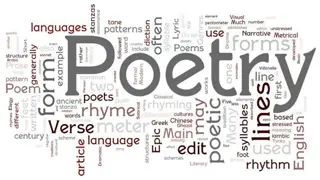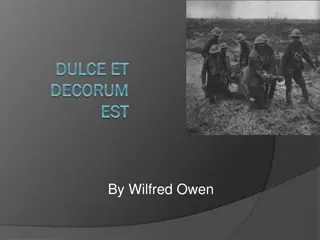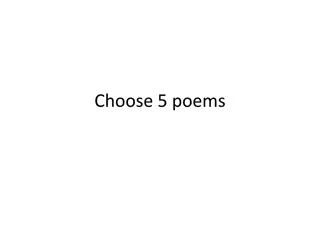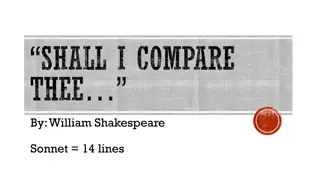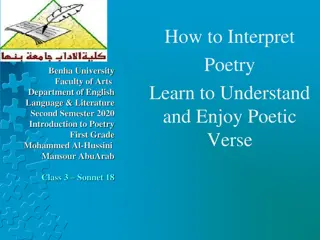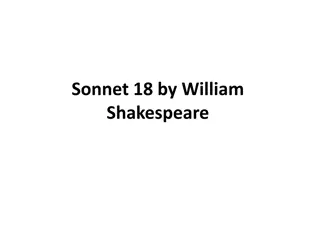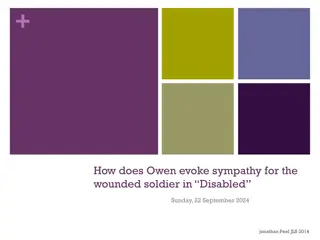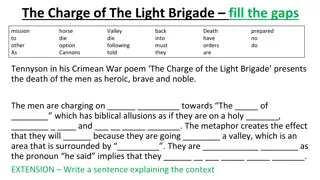Analyzing "The Next War" by Wilfred Owen: A Sonnet of Death and Hope
Wilfred Owen's poem "The Next War" explores shifting perspectives on death and war among soldiers in the trenches, using a unique sonnet structure blending Italian and English forms. Through inclusive language and personification of Death, Owen highlights themes of camaraderie, courage, and the acceptance of mortality in the face of war's grim reality, ultimately revealing a message of hope amidst tragedy.
Download Presentation

Please find below an Image/Link to download the presentation.
The content on the website is provided AS IS for your information and personal use only. It may not be sold, licensed, or shared on other websites without obtaining consent from the author.If you encounter any issues during the download, it is possible that the publisher has removed the file from their server.
You are allowed to download the files provided on this website for personal or commercial use, subject to the condition that they are used lawfully. All files are the property of their respective owners.
The content on the website is provided AS IS for your information and personal use only. It may not be sold, licensed, or shared on other websites without obtaining consent from the author.
E N D
Presentation Transcript
~War Poetry~ Wilfred Owen The Next War
Structure Sonnet form: Sonnets were traditionally love poems. Could Owen have used this form of poetry to bring a lighter mood to the seriousness of death and war? Through this, we can gain some hope and optimism despite the tragedy of the situation. The Next War is a combination of an Italian and an English sonnet. It contains the traditional Italian octave in the first stanza (2 Quatrains) in an ABBA, CDDC rhyme scheme. However, the second stanza (sestet) is structured like an English sonnet, with a quatrain in an EFEF rhyme scheme followed by a rhyming couplet (GG)
Structure cont The Volta (or turning point) was used in sonnets to change the perspective of the poem. This occurs in the second stanza. High modality language is used to declare that death is not the enemy, the opposite of what was presented in stanza 1 where the first 2 quatrains introduce the idea that Death is spitting bullets at them, shaving them, making them weep. However, this final sestet declared the soldiers firm belief there is no need to fear death and that men should fight death directly not other men, as the other men are not responsible for the war.
Meaning This poem focuses on how the soldiers fighting in the trenches changed their ideas of what war is actually about. At first the men enlisted to fight proudly for their country. However, after experiencing the death in the trenches the men now believe that they are fighting to stay alive against Death itself rather than the soldiers from the opposing countries. The soldier s familiarity with seeing soldiers die has also made them become friends with the personified Death.
Intertextuality The poem begins with a quote from Siegfried Sassoon s poem A letter home. This poem was written to Robert Graves fellow war poet. War s a joke for me and you. Wile we know such dreams are true Metaphor: War is said to be a joke. It is a way that war can be manageable for the soldiers if they think of it as a joke. Juxtaposition: Sassoon uses first and 2nd person language to include us all in his view of war. The poem A letter home by Sassoon, from which Owen referenced this quote , is about the dreams that have been taken from the men. However, the men live on in nature and in this way their dreams can triumph over the war. ~Siegfried Sassoon
The Next War Stanza 1 Techniques Inclusive language: Shows camaraderie during the war AOut there we ve walked quote friendly up to Death Capitalisation and Personification: Gives death a tangible presence, shows its power during war, but also humanises it and makes it manageable. B him, cool and bland, Sat down an eaten with Juxtaposition: Death with friendly and eaten shows courage and hope in the face of death. The grimness of death is juxtaposed with the commonplace. B mess-tins in our hand. Pardoned his spilling AWe ve sniffed the green thick odour of his breath. Imagery and Personification: The green this odour is an allusion to the gas attacks described in Dulce et Decorum est. That Death is responsible for the green gas attacks shows how the men are fighting Death.
Stanza 1 cont. Contrast: wept and courage highlights how brave the men were in the face of death. C Our eyes wept, but our courage didn't writhe. Personification: Shows how initially Owen describes the soldiers of fighting death not other men. Highlights how the war is just about survival to the men not to win, which they see as being futile. D He's spat at us with bullets and he's coughed DShrapnel. We chorussed when he sang aloft, Contrast 1st and 3rd person: The inclusive we contrasted with he for Death shows how the men are singing with Death and each are playing their role in the war. C We whistled while he shaved us with his scythe. Imagery: Painting Death as the Grim reaper
Stanza 2 E Oh, Death was never enemy of ours! High modality: Emphasising that Death was not the enemy. Positive connotations and Repetition: laughed suggests the men have overcome their fear of death. Repetition further emphasises this. FWe laughed at him, we leagued with him, old chum. E No soldier's paid to kick against His powers. Personification: No soldier can fight against Death, we usually just accept it. Term of endearment: old chum makes Death seem like a friend resulting from the soldiers familiarity with death. F We laughed, -knowing that better men would come
Stanza 2 cont. Enjambment: The follow on to the last line emphasises the switch to 3rd person when referencing the soldiers. At this point, Owen is highlighting the lessons he has learnt from this war. That is, the soldiers will no longer fight blindly for their country. However, they will fight only for their own life in a direct battle against Death. G And greater wars: when each proud fighter brags G He wars on Death, for lives; not men, for flags. Symbolism: The flag symbolises the countries involved in the war. Owen states that the soldiers in the trenches fight directly against Death for the sake of staying alive, rather than for their countries and military leaders.
